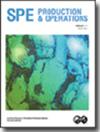Modeling of Smart Pigging for Pipeline Leak Detection
IF 1.3
4区 工程技术
Q2 ENGINEERING, PETROLEUM
引用次数: 0
Abstract
Although leak incidents continue, a pipeline remains the most reliable mode of transportation within the oil and gas industry. It becomes even more important today because the projection for new pipelines is expected to increase by 1 billion barrels of oil equivalent (BOE) through 2035. In addition, increasing the number and length of subsea tiebacks faces new challenges in terms of data acquisition, monitoring, analysis, and remedial actions. Passive leak-detection methods commonly used in the industry have been successful with some limitations, in that they often cannot detect small leaks and seeps. In addition to a thorough review of related topics, this study investigates how to create a framework for a smart pigging technique for pipeline leak detection as an active leak-detection method. Numerical modeling of smart pigging for leak detection requires two crucial components: detailed mathematical descriptions for fluid-solid and solid-solid interactions around pig and network modeling for the calculation of pressure and rate along the pipeline using iterative algorithms. The first step of this study is to build a numerical model that shows the motion of a pig along the pipeline with no leak (i.e., at a given injection rate, a pig first accelerates until it reaches its terminal velocity, beyond which the pig moves at a constant velocity). The second step is to construct a network model that consists of two pipeline segments (one upstream and the other downstream of the leak location) through which the pig travels and at the junction of which fluid leak occurs. By putting these multiple mechanisms together and using resulting pressure signatures, this study presents a new method to predict the location and size of a leak in the pipeline.用于管道泄漏检测的智能清管建模
尽管泄漏事件仍在继续,但管道仍然是石油和天然气行业中最可靠的运输方式。如今,这一点变得更加重要,因为预计到2035年,新管道的数量将增加10亿桶石油当量。此外,增加海底回接的数量和长度在数据采集、监测、分析和补救措施方面面临着新的挑战。工业中常用的被动泄漏检测方法取得了成功,但存在一些局限性,因为它们通常无法检测到小的泄漏和渗漏。除了对相关主题进行全面审查外,本研究还探讨了如何为管道泄漏检测的智能清管技术创建一个框架,作为一种主动泄漏检测方法。用于泄漏检测的智能清管的数值建模需要两个关键组成部分:清管器周围流体-固体和固体-固体相互作用的详细数学描述,以及使用迭代算法计算管道沿线压力和速率的网络建模。本研究的第一步是建立一个数值模型,显示清管器在没有泄漏的情况下沿着管道的运动(即,在给定的注入速率下,清管器首先加速,直到达到其终端速度,超过该速度清管器以恒定速度移动)。第二步是构建一个网络模型,该模型由两个管段(泄漏位置的上游和下游各一个)组成,清管器穿过这两个管节,并在其交界处发生流体泄漏。通过将这些多种机制结合在一起,并使用由此产生的压力特征,本研究提出了一种预测管道泄漏位置和大小的新方法。
本文章由计算机程序翻译,如有差异,请以英文原文为准。
求助全文
约1分钟内获得全文
求助全文
来源期刊

Spe Production & Operations
工程技术-工程:石油
CiteScore
3.70
自引率
8.30%
发文量
54
审稿时长
3 months
期刊介绍:
SPE Production & Operations includes papers on production operations, artificial lift, downhole equipment, formation damage control, multiphase flow, workovers, stimulation, facility design and operations, water treatment, project management, construction methods and equipment, and related PFC systems and emerging technologies.
 求助内容:
求助内容: 应助结果提醒方式:
应助结果提醒方式:


